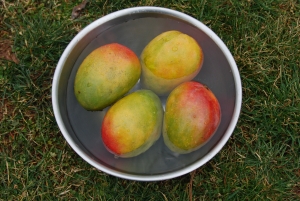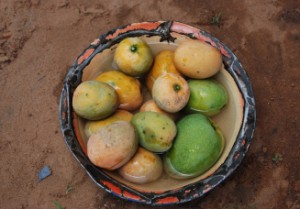This is what I had dreamt about for months since September 2011; eating a mango fruit during the Christmas season in December in my native Zambia in Southern Africa.
 I was standing slightly bent over near the wall on the green nicely manicured lawn of my uncle’s front lawn at the farm in Lusaka in Zambia in Southern Africa. I picked up a fresh bright yellow firm mango from a dish of mangoes in clean water. I rinsed it very briefly and bit into it. The sweet yellow juice gushed into my mouth as the deeply familiar intoxicating flavor from my emotional memory shot through my nose. I proceeded to quickly peel off the skin with my front teeth with familiar precision and skill. I devoured the mango fruit as some of the succulent sweet juice dripped down my elbow as I leaned over preventing the juice from dripping on my shirt. That’s the way to eat a mango for an experienced native eater. This is what I had dreamt about for months since September 2011; eating a mango fruit during the Christmas season in December in my native Zambia in Southern Africa.
I was standing slightly bent over near the wall on the green nicely manicured lawn of my uncle’s front lawn at the farm in Lusaka in Zambia in Southern Africa. I picked up a fresh bright yellow firm mango from a dish of mangoes in clean water. I rinsed it very briefly and bit into it. The sweet yellow juice gushed into my mouth as the deeply familiar intoxicating flavor from my emotional memory shot through my nose. I proceeded to quickly peel off the skin with my front teeth with familiar precision and skill. I devoured the mango fruit as some of the succulent sweet juice dripped down my elbow as I leaned over preventing the juice from dripping on my shirt. That’s the way to eat a mango for an experienced native eater. This is what I had dreamt about for months since September 2011; eating a mango fruit during the Christmas season in December in my native Zambia in Southern Africa.
 I had eaten mangoes all my life. But I had not eaten any since December 1989. The mango fruit is perhaps the most cherished as it is not only hearty but symbolizes so much of life in tropical African such as Zambia. The mango fruit grows naturally both in the fields and in the wild. It never needs fertilizer, manure, weeding, watering, or spraying it with herbicides to kill bugs for it to grow. But it naturally thrives year in and year out, its trees producing abundant fruits every year ripening around December 22nd. This is the beginning of the rainy and planting season when the food harvests from the previous season have run low all over rural Zambia. It is also during the festive holiday season. By the time the mango season finally ends in mid January people in rural areas are barely weeks from eating fresh food from the growing fields.
I had eaten mangoes all my life. But I had not eaten any since December 1989. The mango fruit is perhaps the most cherished as it is not only hearty but symbolizes so much of life in tropical African such as Zambia. The mango fruit grows naturally both in the fields and in the wild. It never needs fertilizer, manure, weeding, watering, or spraying it with herbicides to kill bugs for it to grow. But it naturally thrives year in and year out, its trees producing abundant fruits every year ripening around December 22nd. This is the beginning of the rainy and planting season when the food harvests from the previous season have run low all over rural Zambia. It is also during the festive holiday season. By the time the mango season finally ends in mid January people in rural areas are barely weeks from eating fresh food from the growing fields.
I have eaten dozens of different fruits in my life. The mango has to be a Godly fruit from heaven. When it is mature it is dark green and very tart and harshly acidic to the bite. When ripe it is bright golden yellow and can be spotted from a hundred yards away. Mangoes are so very filling that if you eat just a few before dinner, you may have to skip dinner. That’s why sometimes when I was growing up my mother used to admonish us for eating mangoes just before dinner because we would be too full to eat. But the mango is so irresistible.
The aroma of ripe sticky mangoes in the house with its succulent sweetness is one of the powerful symbols of the December holiday season. The long fiber from the fruit is good for cleansing the stomach and natural flossing of the teeth.
As I dreamt about devouring mangoes in Zambia all last fall, I was finally glad my dreams were realized. One of the dreams was to walk to many mango trees and simply hand pick one or two of the most beautifully ripe fruits and eat them right there and then in the field.  The first day I arrived in the village, I found out there was a loaded mango tree just ten yards behind my house where I was sleeping. In the entire field around our village there were more than ten mango trees. I spent two hours going from tree to tree with two curious eight year old nephews in tow. I ate at least one mango from each tree. When I was done I was so pleasantly full I thought I would explode. That evening my nieces brought me a dish full of more fresh mangoes that I kept by my bed side. I ate a few again before I went to bed and the intoxicating aroma of the fruit filled the hut as I slept.
The first day I arrived in the village, I found out there was a loaded mango tree just ten yards behind my house where I was sleeping. In the entire field around our village there were more than ten mango trees. I spent two hours going from tree to tree with two curious eight year old nephews in tow. I ate at least one mango from each tree. When I was done I was so pleasantly full I thought I would explode. That evening my nieces brought me a dish full of more fresh mangoes that I kept by my bed side. I ate a few again before I went to bed and the intoxicating aroma of the fruit filled the hut as I slept.
There often has been speculation that if ever there was a Garden of Eden it must have been in tropical Africa. Besides bananas, grapes, guava, pawpaws, oranges, apples, and other fruits, God may have created the mango as just the right sweet, juicy, and very hearty fruit to feed Adam and Eve.